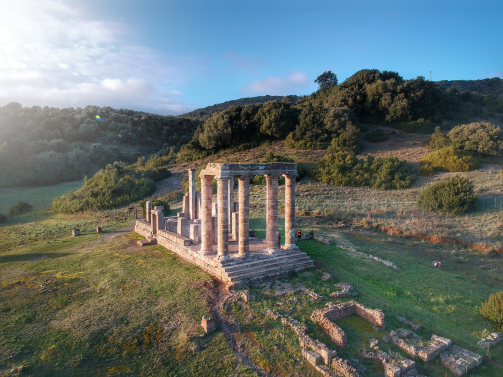The splendid valley of Antas with the majestic columns of the Punic-Roman temple of the same name that make it unique and fascinating, is located in the territory of Fluminimaggiore within the province of Carbonia Iglesias. Lying at the foot of the limestone rampart of Punta Conca s’Omu, it was identified as a place of habitation and worship as far back as the Nuragic period (Final Bronze 1200-900 B.C.); the ancient peoples, of whom a small settlement and a burial area remain (Early Iron Age IX-VIII B.C.), walked along an ancient path that connected the valley with the nearby Su Mannau cave, where there is evidence of the practice of water worship.
The highlight that distinguishes the valley in its uniqueness is the presence of the Punic-Roman temple, discovered in 1836 by General La Marmora and reconstructed since 1967 by archaeologist Ferruccio Barreca. The temple building is divided longitudinally into three parts: pronaos, cella and bipartite adyton; the elevation is tetrastyle and has four frontal and two lateral columns; the place of worship is surmounted by an inscription confirming the worship of the God Sardus Pater Babai and the chronological placement to the third century A.D., as far as the restoration phase under the rule of Emperor Caracalla is concerned. Below the temple are visible the remains of the Carthaginian shrine (500 B.C.) dedicated to the god Sid Addir Babbai.
Near the archaeological area, following a path through the holm oak forest, you can reach the Roman quarries where the limestone blocks used for temple construction were extracted.
The Antas Valley offers the attentive visitor a naturalistic landscape that goes far beyond the historical and cultural aspect; mystical feelings and an almost tangible sacredness are the emotions that the people of the past had already felt in their time.









